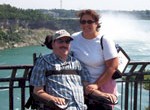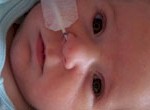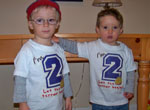Paralyzed Teen Racer Traveling to Portugal for Stem Cell Therapy
September 4, 2009
Source: The Flint Journal
Author: Elizabeth Shaw
VIENNA TWP., Michigan — Racing at speeds upwards of 120 mph, nothing holds Michael Johnson back.
Paralyzed from the waist down in a 2005 motorcycle crash, the Vienna Township teen, 16, uses his hands to propel himself around the track in his specially equipped go-kart — winning one state and one national title in races as far away as Quebec and Florida.
This week, the Frankenmuth High School junior is racing toward another goal: He’s flying to Portugal to undergo an experimental stem cell transplant he hopes will repair his spinal cord and enable him to walk again for the first time since he was 12 years old.
That’s a victory worth any cost, said his parents, Tim and Kathi Johnson, who are paying $50,000 out of pocket for the surgery in addition to travel costs and intensive postoperative rehabilitation therapy for at least a year.
"It’s an absolutely huge deal for us. Just about all the people we’ve talked to have gotten at least some feeling back in the lower part of their body or regained bowel and bladder control," said his dad, Tim Johnson, 50. "He’s told us if he can just get that back, he won’t care if he can’t walk again. He’s still racing and doing the things he really loves. But that one thing would make it so much easier to live his life."
The Portuguese medical team, headed by Dr. Carlos Lima, a neuropathologist, will harvest stem cells from Michael’s nose and transplant them at the spinal cord break, in hopes they will regrow the lost neural connections.
The family knows full well there are no guarantees.
"The reality is you have a pretty debilitating injury with not a lot of immediate avenues that promise recovery. At this time, the best people can do is make the most educated decision you can make about the procedures available and what’s right for you," said Erica Nader, president of Walk the Line, a Southfield clinic that uses a physician-directed activity-based training program for patients with spinal cord injuries, including Michael.
In 2003, Nader was the first patient in the U.S. to undergo the experimental stem cell treatment. She became paralyzed from the shoulders down in a 2001 car accident.
"I have my abdominal and back muscles now, most of my arm muscles , 30-50 percent of my hand function and some leg function. I feel like it was worthwhile for me, but I can’t say that’s all from the surgery," said Nader, 31. "I’ve used a whole host of supportive therapies, too: acupuncture, intensive exercise therapy, massage. With the help of all that I’m continuing to see some improvements."
Still, the odds are good for Michael, she said.
"The science is moving forward all the time. Eight years ago, they sent a psychiatrist to my room when I started talking about recovery. It’s only recently it seems like it’s on the frontier of really happening," she said. "Michael is also in a unique position where he’s at a younger age when your body will respond to any kind of treatment better."
Most of all, he’s a determined young man used to winning whatever he sets out to do, said his father.
In 2005, Michael already held 14 national championships and was dreaming of a professional career following in the footsteps of his dad, a former American Motorcyclist Association pro rider.
During a race in Sarnia, Ontario, he was making his move into the lead when he lost control of his 250cc bike and crashed through a railing, barely 20 feet from where his dad stood watching.
"The first thing he said to me was ‘I can’t feel my legs.’ The next words out of his mouth were ‘Don’t make me quit racing.’ He was more worried about that than his injuries," said Johnson, owner of Universal Coating in Genesee Township.
Michael was still recovering at Children’s Hospital of Michigan in Detroit, fighting his way through the surgeries and setbacks of spinal cord injuries, when he announced he had no plans to quit racing: He’d simply become the first paralyzed IndyCar champion.
Next year, he’s moving up into Star Mazda auto racing, the next step toward that goal.
"Racing was my life before, and it still is now. Once you’ve got it in your blood, you’ll never get it out," Michael said. "I knew I wasn’t going to stop. I just had to find another way to do it."
But racing might have to take a back seat for a while. Once he returns from Portugal, he’ll have to be home-schooled for a year so he can spend three days a week at Walk the Line.
"All of it would change my life, just to get anything back," Michael said. "I know it’s going to take a lot of work. I don’t mind at all. I’m used to working hard for what I want."



